Economics Study Material and Solved Assignments
VerifiedAdded on 2023/03/17
|20
|2427
|69
AI Summary
Find comprehensive study material and solved assignments for Economics at Desklib. Get expert assistance for your Economics assignments and essays.
Contribute Materials
Your contribution can guide someone’s learning journey. Share your
documents today.
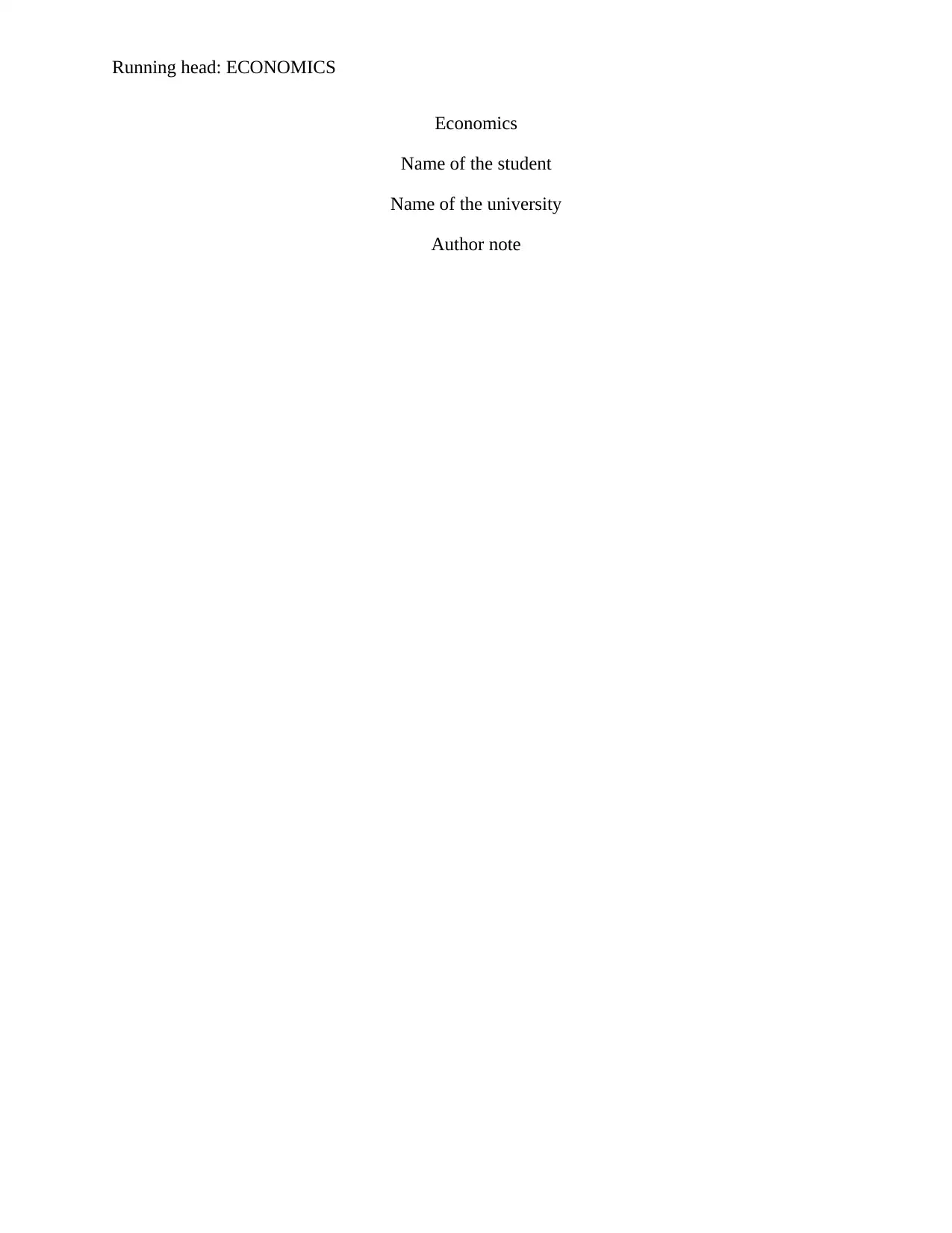
Running head: ECONOMICS
Economics
Name of the student
Name of the university
Author note
Economics
Name of the student
Name of the university
Author note
Secure Best Marks with AI Grader
Need help grading? Try our AI Grader for instant feedback on your assignments.
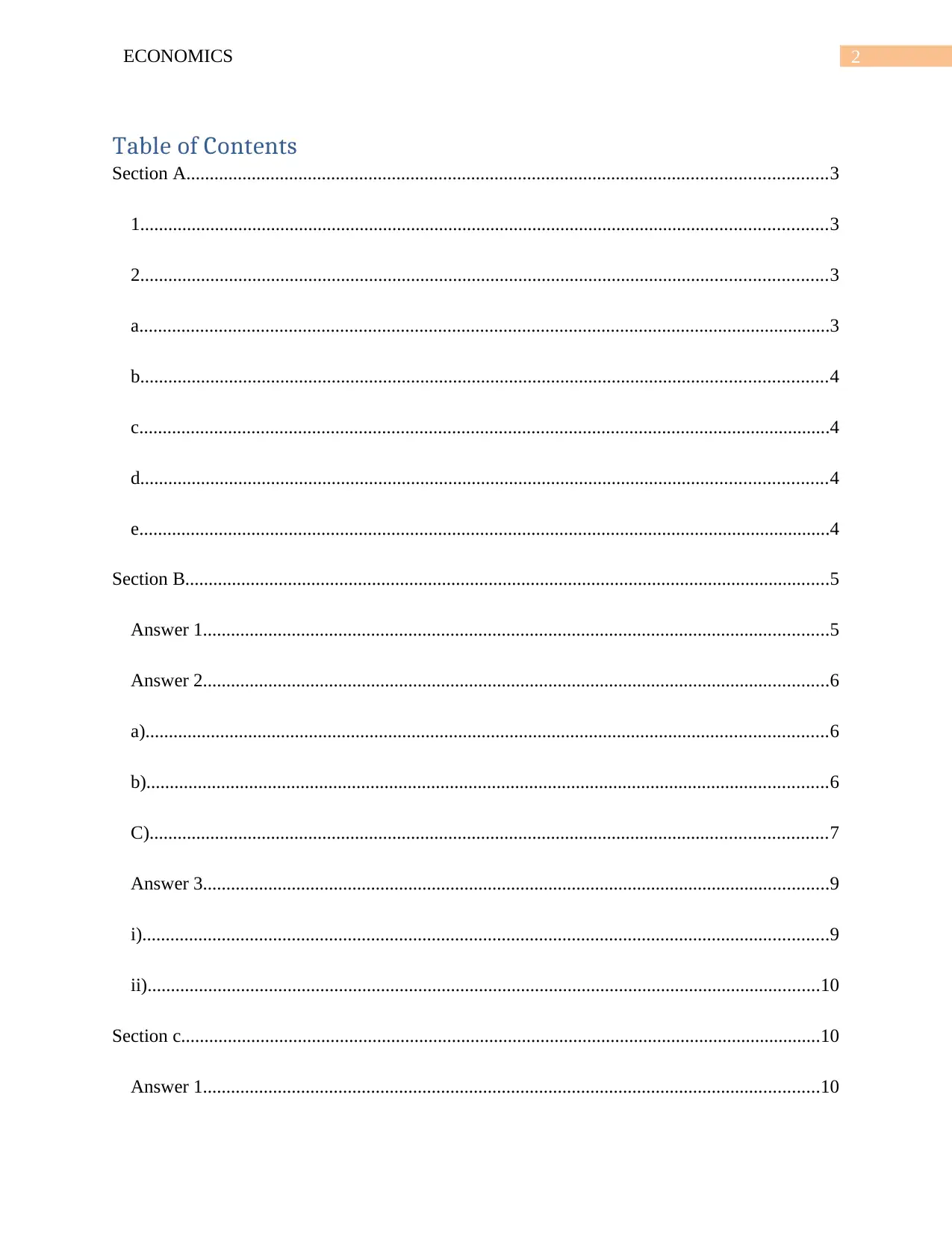
2ECONOMICS
Table of Contents
Section A.........................................................................................................................................3
1...................................................................................................................................................3
2...................................................................................................................................................3
a....................................................................................................................................................3
b...................................................................................................................................................4
c....................................................................................................................................................4
d...................................................................................................................................................4
e....................................................................................................................................................4
Section B..........................................................................................................................................5
Answer 1......................................................................................................................................5
Answer 2......................................................................................................................................6
a)..................................................................................................................................................6
b)..................................................................................................................................................6
C).................................................................................................................................................7
Answer 3......................................................................................................................................9
i)...................................................................................................................................................9
ii)................................................................................................................................................10
Section c.........................................................................................................................................10
Answer 1....................................................................................................................................10
Table of Contents
Section A.........................................................................................................................................3
1...................................................................................................................................................3
2...................................................................................................................................................3
a....................................................................................................................................................3
b...................................................................................................................................................4
c....................................................................................................................................................4
d...................................................................................................................................................4
e....................................................................................................................................................4
Section B..........................................................................................................................................5
Answer 1......................................................................................................................................5
Answer 2......................................................................................................................................6
a)..................................................................................................................................................6
b)..................................................................................................................................................6
C).................................................................................................................................................7
Answer 3......................................................................................................................................9
i)...................................................................................................................................................9
ii)................................................................................................................................................10
Section c.........................................................................................................................................10
Answer 1....................................................................................................................................10
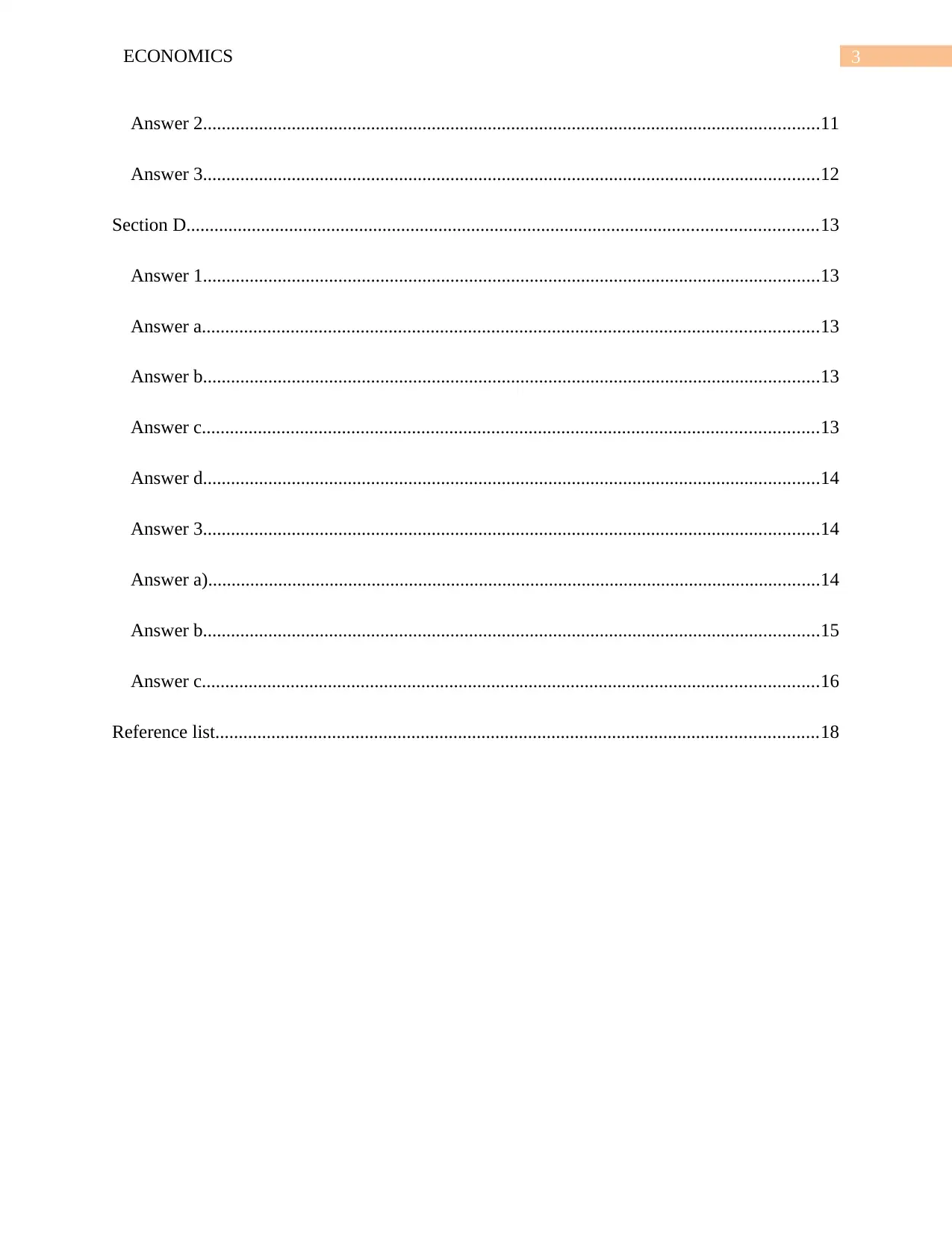
3ECONOMICS
Answer 2....................................................................................................................................11
Answer 3....................................................................................................................................12
Section D.......................................................................................................................................13
Answer 1....................................................................................................................................13
Answer a....................................................................................................................................13
Answer b....................................................................................................................................13
Answer c....................................................................................................................................13
Answer d....................................................................................................................................14
Answer 3....................................................................................................................................14
Answer a)...................................................................................................................................14
Answer b....................................................................................................................................15
Answer c....................................................................................................................................16
Reference list.................................................................................................................................18
Answer 2....................................................................................................................................11
Answer 3....................................................................................................................................12
Section D.......................................................................................................................................13
Answer 1....................................................................................................................................13
Answer a....................................................................................................................................13
Answer b....................................................................................................................................13
Answer c....................................................................................................................................13
Answer d....................................................................................................................................14
Answer 3....................................................................................................................................14
Answer a)...................................................................................................................................14
Answer b....................................................................................................................................15
Answer c....................................................................................................................................16
Reference list.................................................................................................................................18

4ECONOMICS
Section A
1.
The consumer price index is known to measure the change in the price level of market basket for
the consumer goods. Changes in the cost price index will be used for assessing changes in price
which is associated with the living cost Wang, J.,( Koblyakova Tiwari & Croucher 2018). The
CPI is known to be one of the frequently used statistics in order to identify periods of deflation or
inflation.
The consumer price index is the variation in the price for a given basket of goods and services
that is calculated by
CPI= Price of desired basket ∈current year
Price of desired basket ∈base year × 100
2.
a.
The gross domestic product is known as the broad measurement of the overall economic activity
of the nation. The GDP is the monetary value of all finished services and goods which are known
to be produced within the country’s borders in the specific time period.
GDP= C+I+G+NX
23100+9500+6200+(13300−15100)
Section A
1.
The consumer price index is known to measure the change in the price level of market basket for
the consumer goods. Changes in the cost price index will be used for assessing changes in price
which is associated with the living cost Wang, J.,( Koblyakova Tiwari & Croucher 2018). The
CPI is known to be one of the frequently used statistics in order to identify periods of deflation or
inflation.
The consumer price index is the variation in the price for a given basket of goods and services
that is calculated by
CPI= Price of desired basket ∈current year
Price of desired basket ∈base year × 100
2.
a.
The gross domestic product is known as the broad measurement of the overall economic activity
of the nation. The GDP is the monetary value of all finished services and goods which are known
to be produced within the country’s borders in the specific time period.
GDP= C+I+G+NX
23100+9500+6200+(13300−15100)
Paraphrase This Document
Need a fresh take? Get an instant paraphrase of this document with our AI Paraphraser
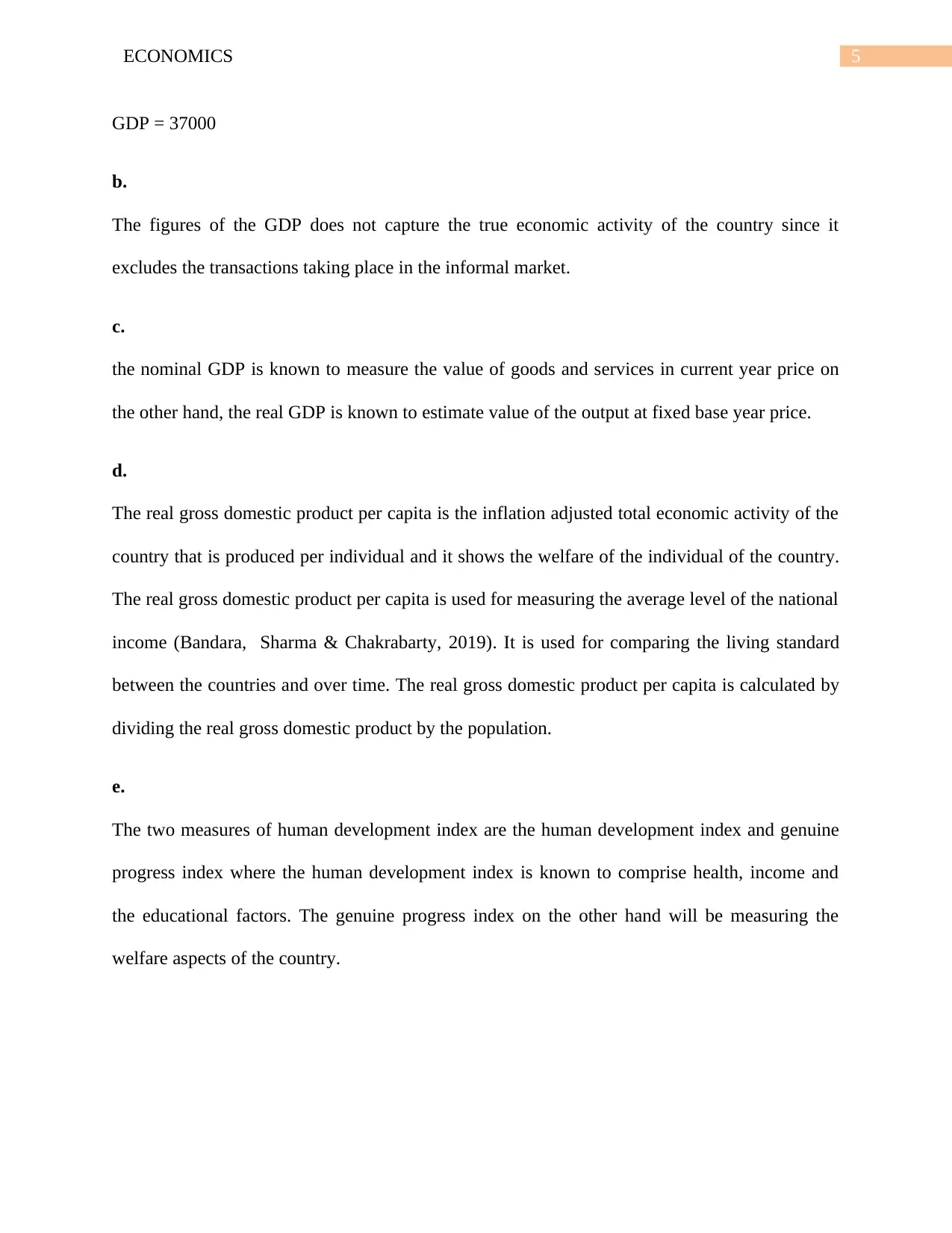
5ECONOMICS
GDP = 37000
b.
The figures of the GDP does not capture the true economic activity of the country since it
excludes the transactions taking place in the informal market.
c.
the nominal GDP is known to measure the value of goods and services in current year price on
the other hand, the real GDP is known to estimate value of the output at fixed base year price.
d.
The real gross domestic product per capita is the inflation adjusted total economic activity of the
country that is produced per individual and it shows the welfare of the individual of the country.
The real gross domestic product per capita is used for measuring the average level of the national
income (Bandara, Sharma & Chakrabarty, 2019). It is used for comparing the living standard
between the countries and over time. The real gross domestic product per capita is calculated by
dividing the real gross domestic product by the population.
e.
The two measures of human development index are the human development index and genuine
progress index where the human development index is known to comprise health, income and
the educational factors. The genuine progress index on the other hand will be measuring the
welfare aspects of the country.
GDP = 37000
b.
The figures of the GDP does not capture the true economic activity of the country since it
excludes the transactions taking place in the informal market.
c.
the nominal GDP is known to measure the value of goods and services in current year price on
the other hand, the real GDP is known to estimate value of the output at fixed base year price.
d.
The real gross domestic product per capita is the inflation adjusted total economic activity of the
country that is produced per individual and it shows the welfare of the individual of the country.
The real gross domestic product per capita is used for measuring the average level of the national
income (Bandara, Sharma & Chakrabarty, 2019). It is used for comparing the living standard
between the countries and over time. The real gross domestic product per capita is calculated by
dividing the real gross domestic product by the population.
e.
The two measures of human development index are the human development index and genuine
progress index where the human development index is known to comprise health, income and
the educational factors. The genuine progress index on the other hand will be measuring the
welfare aspects of the country.
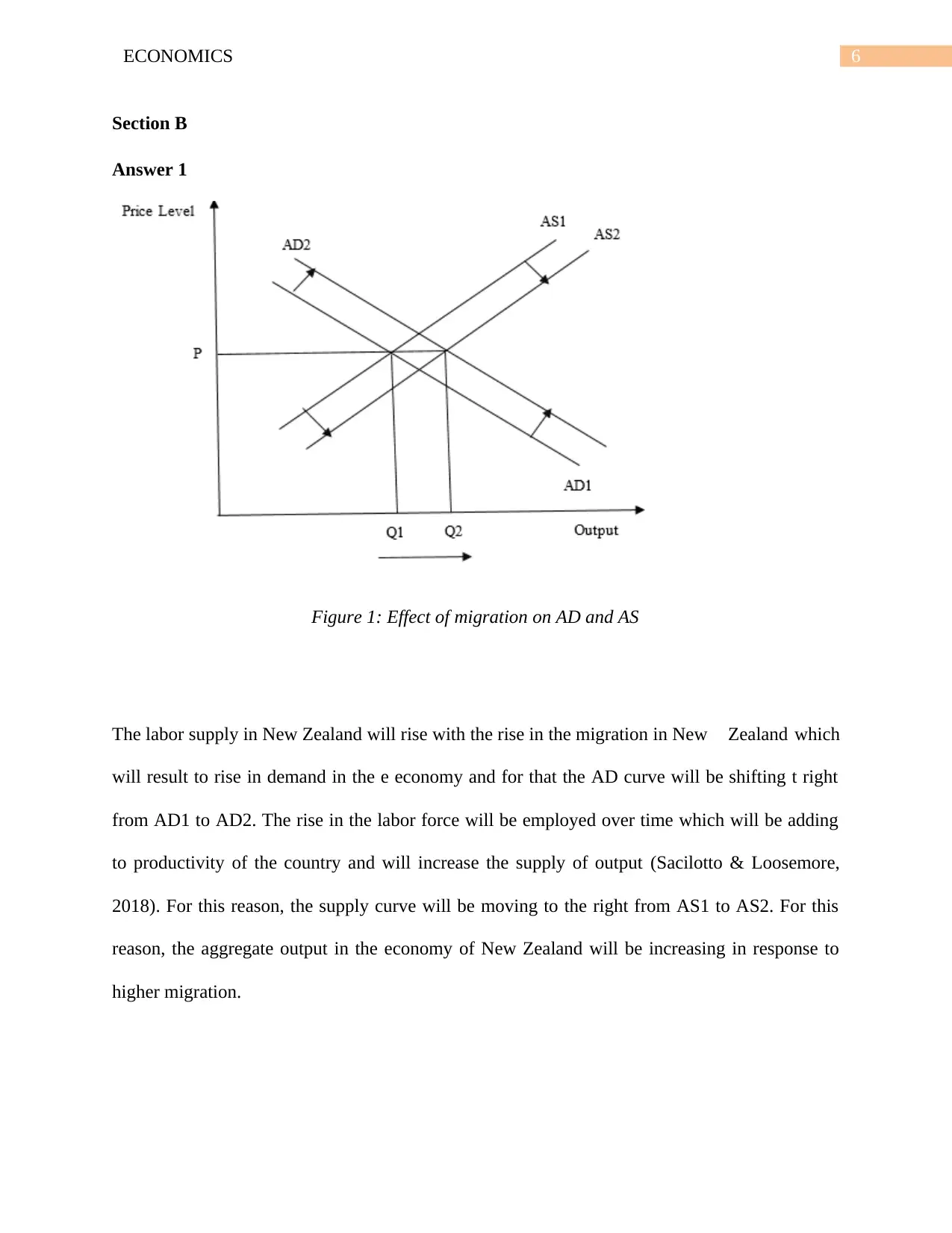
6ECONOMICS
Section B
Answer 1
Figure 1: Effect of migration on AD and AS
The labor supply in New Zealand will rise with the rise in the migration in New Zealand which
will result to rise in demand in the e economy and for that the AD curve will be shifting t right
from AD1 to AD2. The rise in the labor force will be employed over time which will be adding
to productivity of the country and will increase the supply of output (Sacilotto & Loosemore,
2018). For this reason, the supply curve will be moving to the right from AS1 to AS2. For this
reason, the aggregate output in the economy of New Zealand will be increasing in response to
higher migration.
Section B
Answer 1
Figure 1: Effect of migration on AD and AS
The labor supply in New Zealand will rise with the rise in the migration in New Zealand which
will result to rise in demand in the e economy and for that the AD curve will be shifting t right
from AD1 to AD2. The rise in the labor force will be employed over time which will be adding
to productivity of the country and will increase the supply of output (Sacilotto & Loosemore,
2018). For this reason, the supply curve will be moving to the right from AS1 to AS2. For this
reason, the aggregate output in the economy of New Zealand will be increasing in response to
higher migration.

7ECONOMICS
Answer 2
a)
A fall in business confidence
Figure 2: Effect of fall in business confidence
The decline in the business confidence will be decreasing the gross domestic product that
will decrease inflation and increase the rate of unemployment.
b)
Significant increase in household savings
Answer 2
a)
A fall in business confidence
Figure 2: Effect of fall in business confidence
The decline in the business confidence will be decreasing the gross domestic product that
will decrease inflation and increase the rate of unemployment.
b)
Significant increase in household savings
Secure Best Marks with AI Grader
Need help grading? Try our AI Grader for instant feedback on your assignments.

8ECONOMICS
Figure 3: Effect of increased savings
The rise in the household savings will be decreasing the aggregate demand in the economy
which will then create deflationary effect and the price level will then decline (Bandara, Sharma
& Chakrabarty, 2019). The contraction in the economic activity will be increasing the level of
unemployment in the economy.
C)
Increase in business confidence
Figure 3: Effect of increased savings
The rise in the household savings will be decreasing the aggregate demand in the economy
which will then create deflationary effect and the price level will then decline (Bandara, Sharma
& Chakrabarty, 2019). The contraction in the economic activity will be increasing the level of
unemployment in the economy.
C)
Increase in business confidence
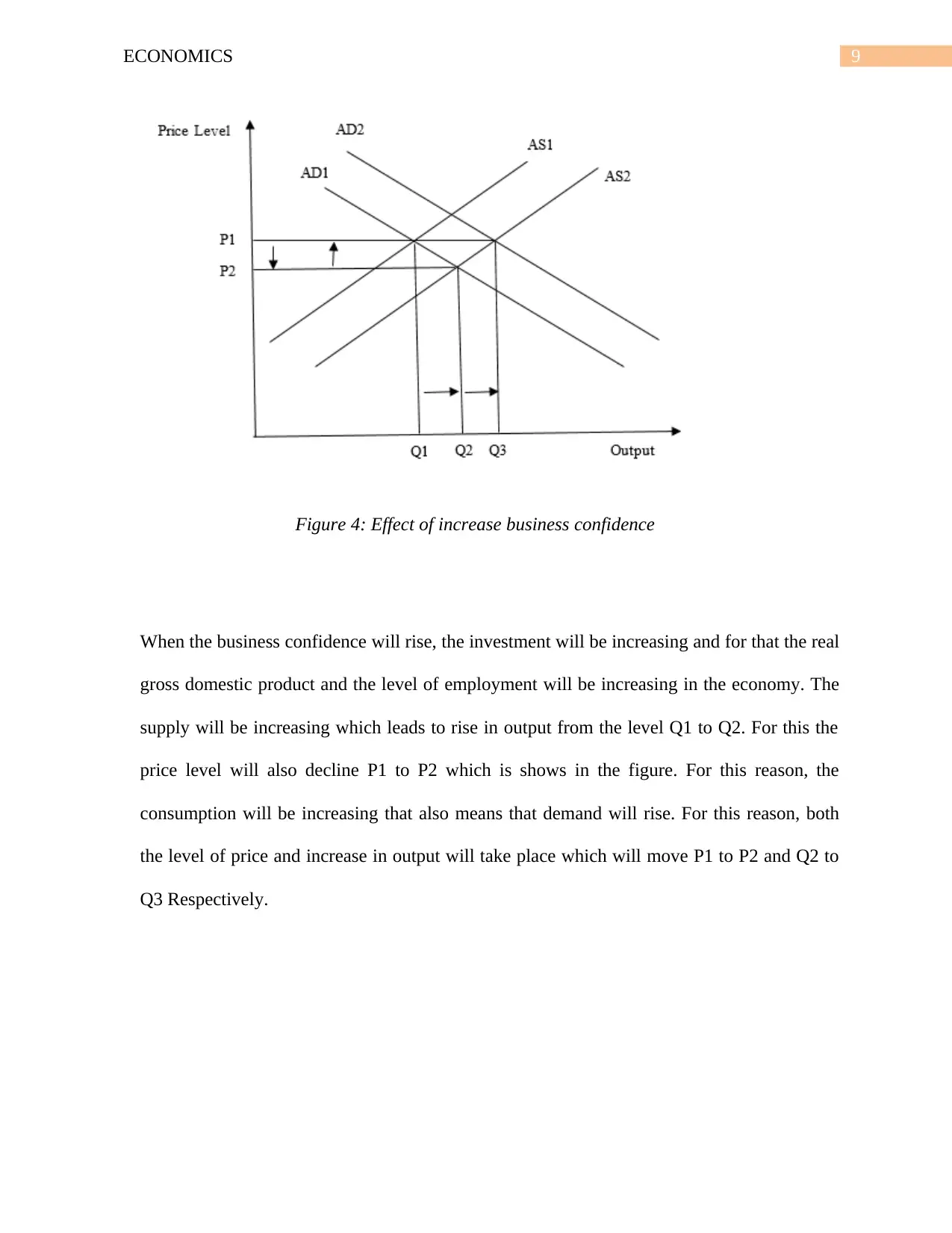
9ECONOMICS
Figure 4: Effect of increase business confidence
When the business confidence will rise, the investment will be increasing and for that the real
gross domestic product and the level of employment will be increasing in the economy. The
supply will be increasing which leads to rise in output from the level Q1 to Q2. For this the
price level will also decline P1 to P2 which is shows in the figure. For this reason, the
consumption will be increasing that also means that demand will rise. For this reason, both
the level of price and increase in output will take place which will move P1 to P2 and Q2 to
Q3 Respectively.
Figure 4: Effect of increase business confidence
When the business confidence will rise, the investment will be increasing and for that the real
gross domestic product and the level of employment will be increasing in the economy. The
supply will be increasing which leads to rise in output from the level Q1 to Q2. For this the
price level will also decline P1 to P2 which is shows in the figure. For this reason, the
consumption will be increasing that also means that demand will rise. For this reason, both
the level of price and increase in output will take place which will move P1 to P2 and Q2 to
Q3 Respectively.

10ECONOMICS
Answer 3
i)
Figure 5: Recessionary Gap
From the above figure it can be said that Q* is stated as the potential national income and on
the other hand Qe is known as the existing national income where Q* is known to be less
than Qe. For this reason, there will be a presence of recessionary gap that is known to
provide by the difference present between Qe and Q*
Answer 3
i)
Figure 5: Recessionary Gap
From the above figure it can be said that Q* is stated as the potential national income and on
the other hand Qe is known as the existing national income where Q* is known to be less
than Qe. For this reason, there will be a presence of recessionary gap that is known to
provide by the difference present between Qe and Q*
Paraphrase This Document
Need a fresh take? Get an instant paraphrase of this document with our AI Paraphraser
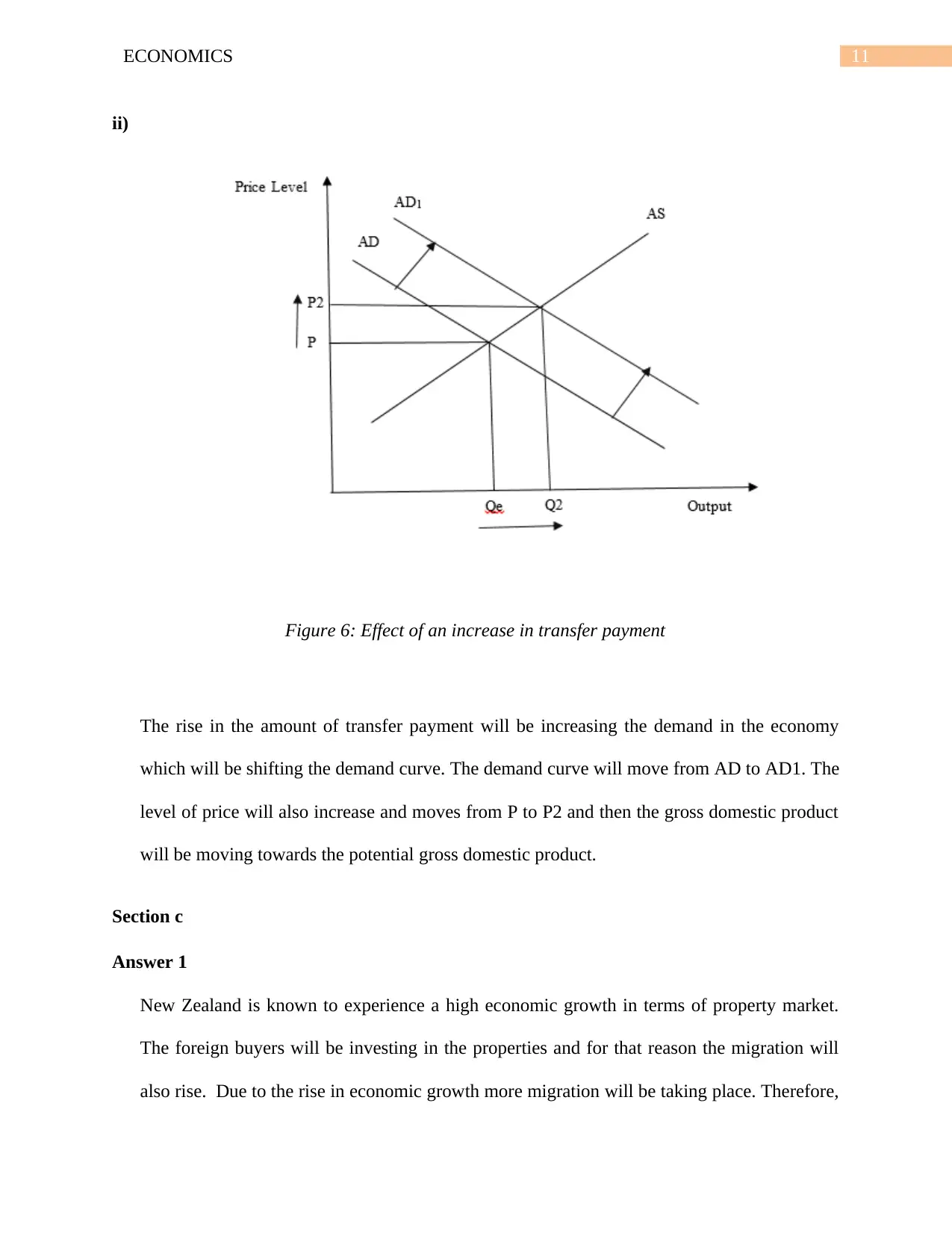
11ECONOMICS
ii)
Figure 6: Effect of an increase in transfer payment
The rise in the amount of transfer payment will be increasing the demand in the economy
which will be shifting the demand curve. The demand curve will move from AD to AD1. The
level of price will also increase and moves from P to P2 and then the gross domestic product
will be moving towards the potential gross domestic product.
Section c
Answer 1
New Zealand is known to experience a high economic growth in terms of property market.
The foreign buyers will be investing in the properties and for that reason the migration will
also rise. Due to the rise in economic growth more migration will be taking place. Therefore,
ii)
Figure 6: Effect of an increase in transfer payment
The rise in the amount of transfer payment will be increasing the demand in the economy
which will be shifting the demand curve. The demand curve will move from AD to AD1. The
level of price will also increase and moves from P to P2 and then the gross domestic product
will be moving towards the potential gross domestic product.
Section c
Answer 1
New Zealand is known to experience a high economic growth in terms of property market.
The foreign buyers will be investing in the properties and for that reason the migration will
also rise. Due to the rise in economic growth more migration will be taking place. Therefore,
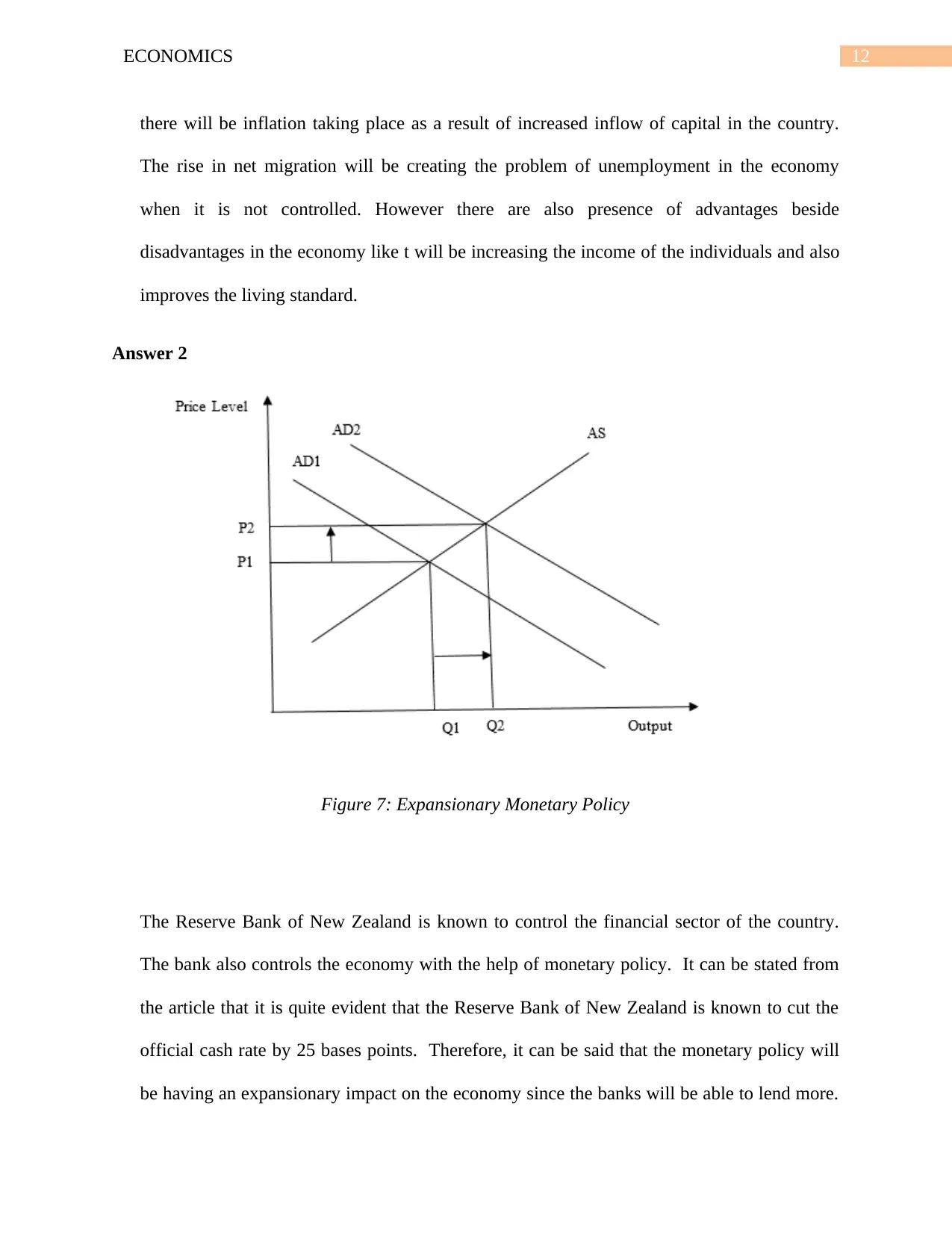
12ECONOMICS
there will be inflation taking place as a result of increased inflow of capital in the country.
The rise in net migration will be creating the problem of unemployment in the economy
when it is not controlled. However there are also presence of advantages beside
disadvantages in the economy like t will be increasing the income of the individuals and also
improves the living standard.
Answer 2
Figure 7: Expansionary Monetary Policy
The Reserve Bank of New Zealand is known to control the financial sector of the country.
The bank also controls the economy with the help of monetary policy. It can be stated from
the article that it is quite evident that the Reserve Bank of New Zealand is known to cut the
official cash rate by 25 bases points. Therefore, it can be said that the monetary policy will
be having an expansionary impact on the economy since the banks will be able to lend more.
there will be inflation taking place as a result of increased inflow of capital in the country.
The rise in net migration will be creating the problem of unemployment in the economy
when it is not controlled. However there are also presence of advantages beside
disadvantages in the economy like t will be increasing the income of the individuals and also
improves the living standard.
Answer 2
Figure 7: Expansionary Monetary Policy
The Reserve Bank of New Zealand is known to control the financial sector of the country.
The bank also controls the economy with the help of monetary policy. It can be stated from
the article that it is quite evident that the Reserve Bank of New Zealand is known to cut the
official cash rate by 25 bases points. Therefore, it can be said that the monetary policy will
be having an expansionary impact on the economy since the banks will be able to lend more.
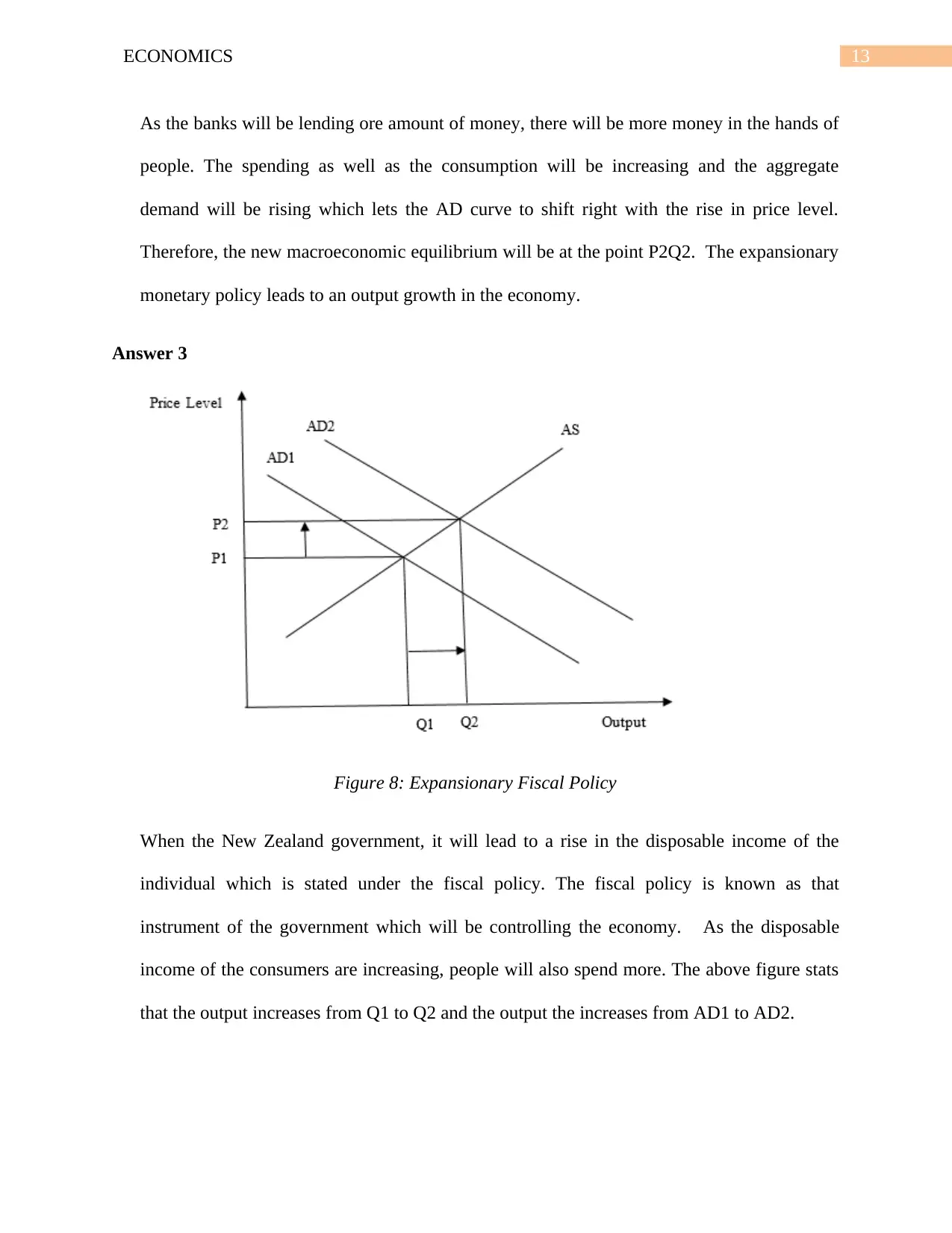
13ECONOMICS
As the banks will be lending ore amount of money, there will be more money in the hands of
people. The spending as well as the consumption will be increasing and the aggregate
demand will be rising which lets the AD curve to shift right with the rise in price level.
Therefore, the new macroeconomic equilibrium will be at the point P2Q2. The expansionary
monetary policy leads to an output growth in the economy.
Answer 3
Figure 8: Expansionary Fiscal Policy
When the New Zealand government, it will lead to a rise in the disposable income of the
individual which is stated under the fiscal policy. The fiscal policy is known as that
instrument of the government which will be controlling the economy. As the disposable
income of the consumers are increasing, people will also spend more. The above figure stats
that the output increases from Q1 to Q2 and the output the increases from AD1 to AD2.
As the banks will be lending ore amount of money, there will be more money in the hands of
people. The spending as well as the consumption will be increasing and the aggregate
demand will be rising which lets the AD curve to shift right with the rise in price level.
Therefore, the new macroeconomic equilibrium will be at the point P2Q2. The expansionary
monetary policy leads to an output growth in the economy.
Answer 3
Figure 8: Expansionary Fiscal Policy
When the New Zealand government, it will lead to a rise in the disposable income of the
individual which is stated under the fiscal policy. The fiscal policy is known as that
instrument of the government which will be controlling the economy. As the disposable
income of the consumers are increasing, people will also spend more. The above figure stats
that the output increases from Q1 to Q2 and the output the increases from AD1 to AD2.
Secure Best Marks with AI Grader
Need help grading? Try our AI Grader for instant feedback on your assignments.
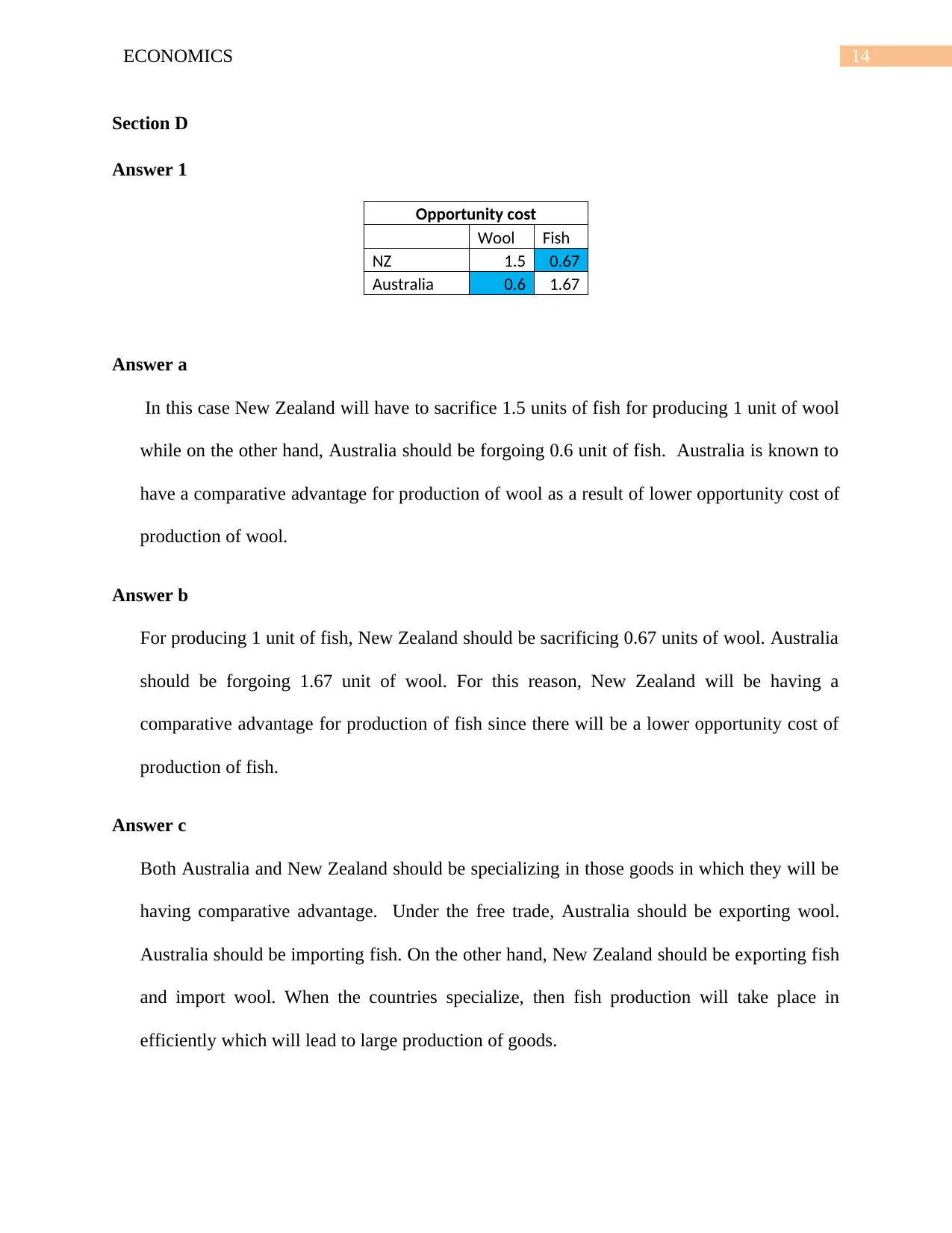
14ECONOMICS
Section D
Answer 1
Opportunity cost
Wool Fish
NZ 1.5 0.67
Australia 0.6 1.67
Answer a
In this case New Zealand will have to sacrifice 1.5 units of fish for producing 1 unit of wool
while on the other hand, Australia should be forgoing 0.6 unit of fish. Australia is known to
have a comparative advantage for production of wool as a result of lower opportunity cost of
production of wool.
Answer b
For producing 1 unit of fish, New Zealand should be sacrificing 0.67 units of wool. Australia
should be forgoing 1.67 unit of wool. For this reason, New Zealand will be having a
comparative advantage for production of fish since there will be a lower opportunity cost of
production of fish.
Answer c
Both Australia and New Zealand should be specializing in those goods in which they will be
having comparative advantage. Under the free trade, Australia should be exporting wool.
Australia should be importing fish. On the other hand, New Zealand should be exporting fish
and import wool. When the countries specialize, then fish production will take place in
efficiently which will lead to large production of goods.
Section D
Answer 1
Opportunity cost
Wool Fish
NZ 1.5 0.67
Australia 0.6 1.67
Answer a
In this case New Zealand will have to sacrifice 1.5 units of fish for producing 1 unit of wool
while on the other hand, Australia should be forgoing 0.6 unit of fish. Australia is known to
have a comparative advantage for production of wool as a result of lower opportunity cost of
production of wool.
Answer b
For producing 1 unit of fish, New Zealand should be sacrificing 0.67 units of wool. Australia
should be forgoing 1.67 unit of wool. For this reason, New Zealand will be having a
comparative advantage for production of fish since there will be a lower opportunity cost of
production of fish.
Answer c
Both Australia and New Zealand should be specializing in those goods in which they will be
having comparative advantage. Under the free trade, Australia should be exporting wool.
Australia should be importing fish. On the other hand, New Zealand should be exporting fish
and import wool. When the countries specialize, then fish production will take place in
efficiently which will lead to large production of goods.
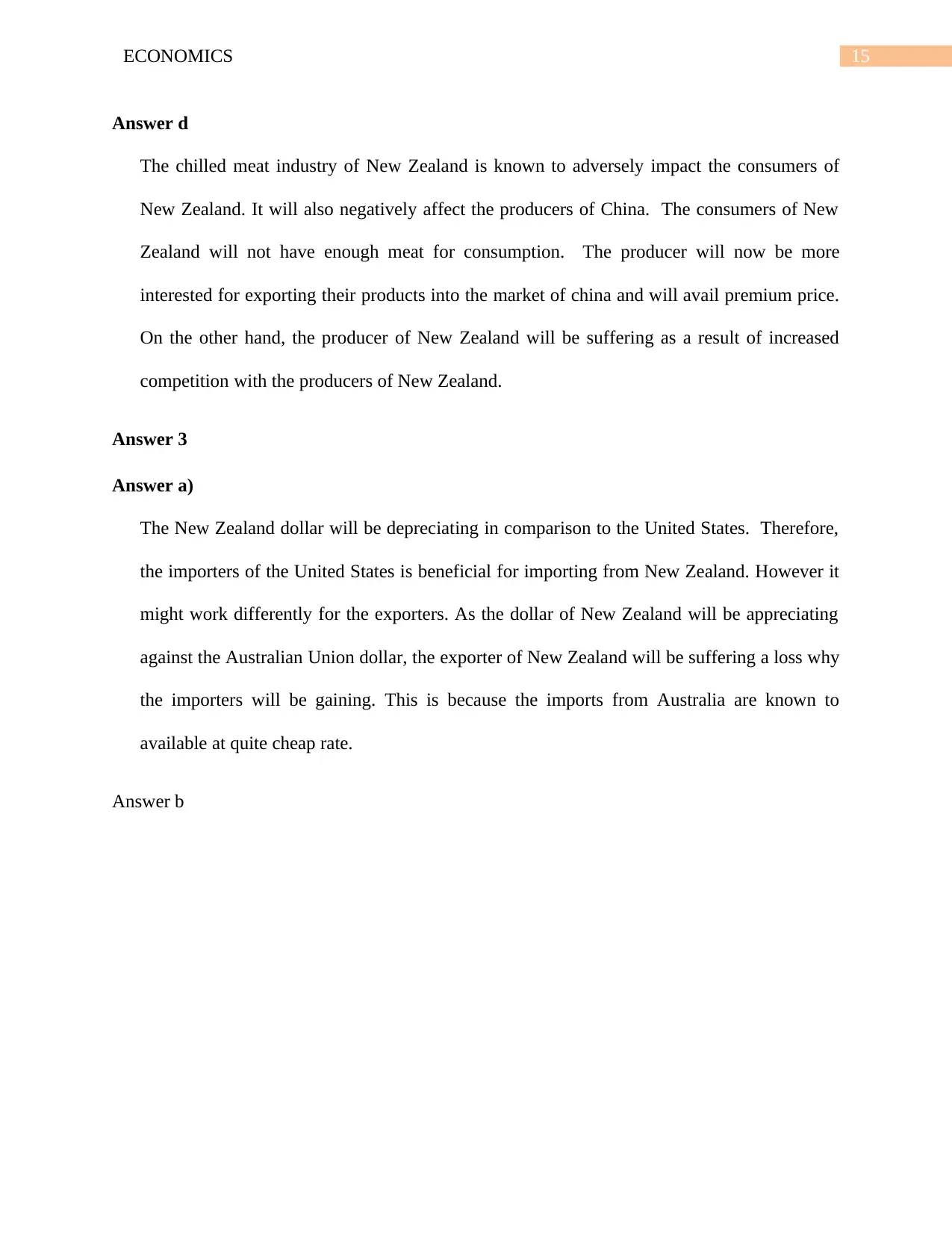
15ECONOMICS
Answer d
The chilled meat industry of New Zealand is known to adversely impact the consumers of
New Zealand. It will also negatively affect the producers of China. The consumers of New
Zealand will not have enough meat for consumption. The producer will now be more
interested for exporting their products into the market of china and will avail premium price.
On the other hand, the producer of New Zealand will be suffering as a result of increased
competition with the producers of New Zealand.
Answer 3
Answer a)
The New Zealand dollar will be depreciating in comparison to the United States. Therefore,
the importers of the United States is beneficial for importing from New Zealand. However it
might work differently for the exporters. As the dollar of New Zealand will be appreciating
against the Australian Union dollar, the exporter of New Zealand will be suffering a loss why
the importers will be gaining. This is because the imports from Australia are known to
available at quite cheap rate.
Answer b
Answer d
The chilled meat industry of New Zealand is known to adversely impact the consumers of
New Zealand. It will also negatively affect the producers of China. The consumers of New
Zealand will not have enough meat for consumption. The producer will now be more
interested for exporting their products into the market of china and will avail premium price.
On the other hand, the producer of New Zealand will be suffering as a result of increased
competition with the producers of New Zealand.
Answer 3
Answer a)
The New Zealand dollar will be depreciating in comparison to the United States. Therefore,
the importers of the United States is beneficial for importing from New Zealand. However it
might work differently for the exporters. As the dollar of New Zealand will be appreciating
against the Australian Union dollar, the exporter of New Zealand will be suffering a loss why
the importers will be gaining. This is because the imports from Australia are known to
available at quite cheap rate.
Answer b
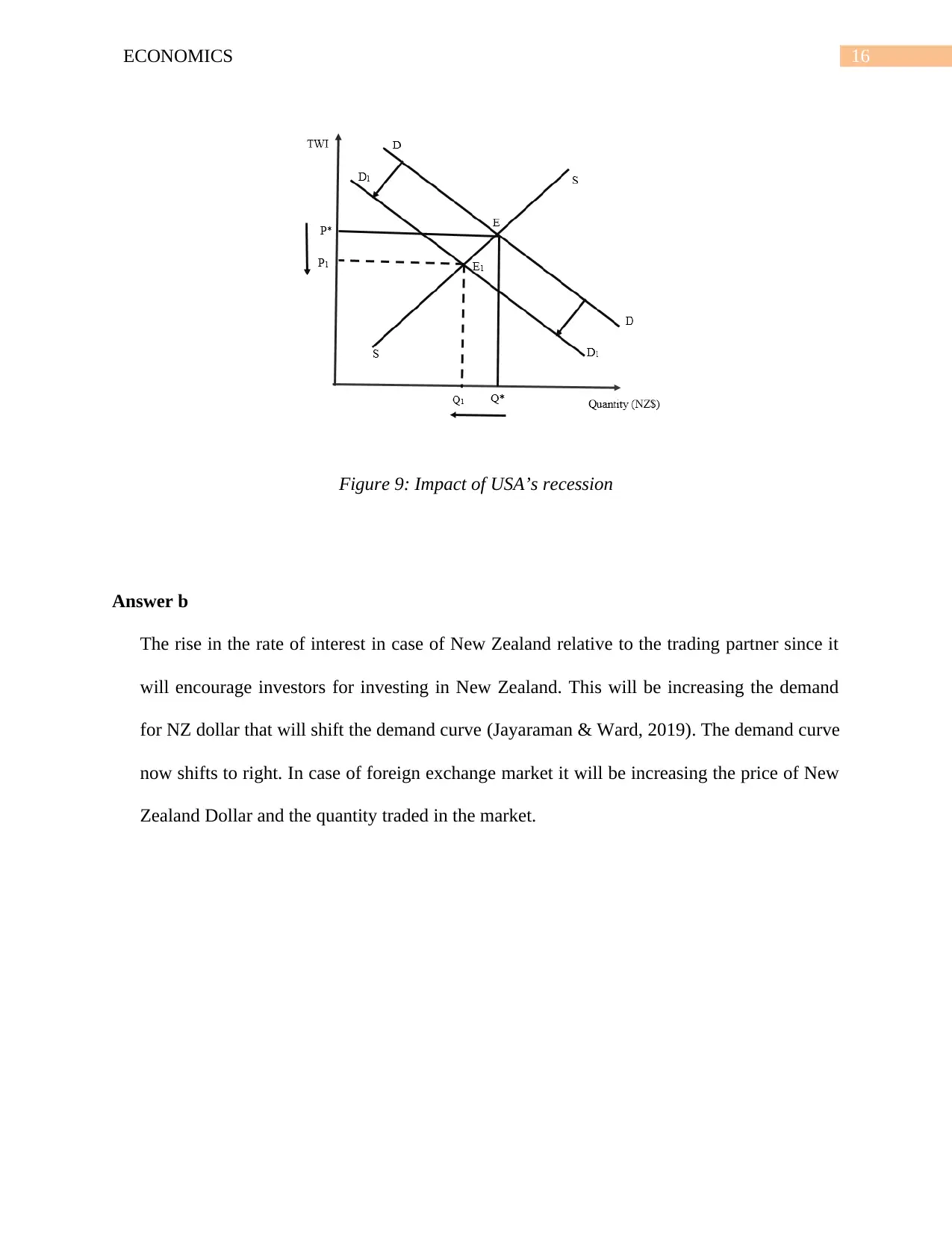
16ECONOMICS
Figure 9: Impact of USA’s recession
Answer b
The rise in the rate of interest in case of New Zealand relative to the trading partner since it
will encourage investors for investing in New Zealand. This will be increasing the demand
for NZ dollar that will shift the demand curve (Jayaraman & Ward, 2019). The demand curve
now shifts to right. In case of foreign exchange market it will be increasing the price of New
Zealand Dollar and the quantity traded in the market.
Figure 9: Impact of USA’s recession
Answer b
The rise in the rate of interest in case of New Zealand relative to the trading partner since it
will encourage investors for investing in New Zealand. This will be increasing the demand
for NZ dollar that will shift the demand curve (Jayaraman & Ward, 2019). The demand curve
now shifts to right. In case of foreign exchange market it will be increasing the price of New
Zealand Dollar and the quantity traded in the market.
Paraphrase This Document
Need a fresh take? Get an instant paraphrase of this document with our AI Paraphraser

17ECONOMICS
Figure 10: Impact of increase in interest rate
Answer c
The expansion in the industries of New Zealand which will compete successfully against the
imported substitutes and exceed in export markets. The following circumstances will be
shifting the demand curve of the New Zealand dollar. Tis will be raising price and increase
the equilibrium quantity of the New Zealand dollar in the market.
Figure 10: Impact of increase in interest rate
Answer c
The expansion in the industries of New Zealand which will compete successfully against the
imported substitutes and exceed in export markets. The following circumstances will be
shifting the demand curve of the New Zealand dollar. Tis will be raising price and increase
the equilibrium quantity of the New Zealand dollar in the market.
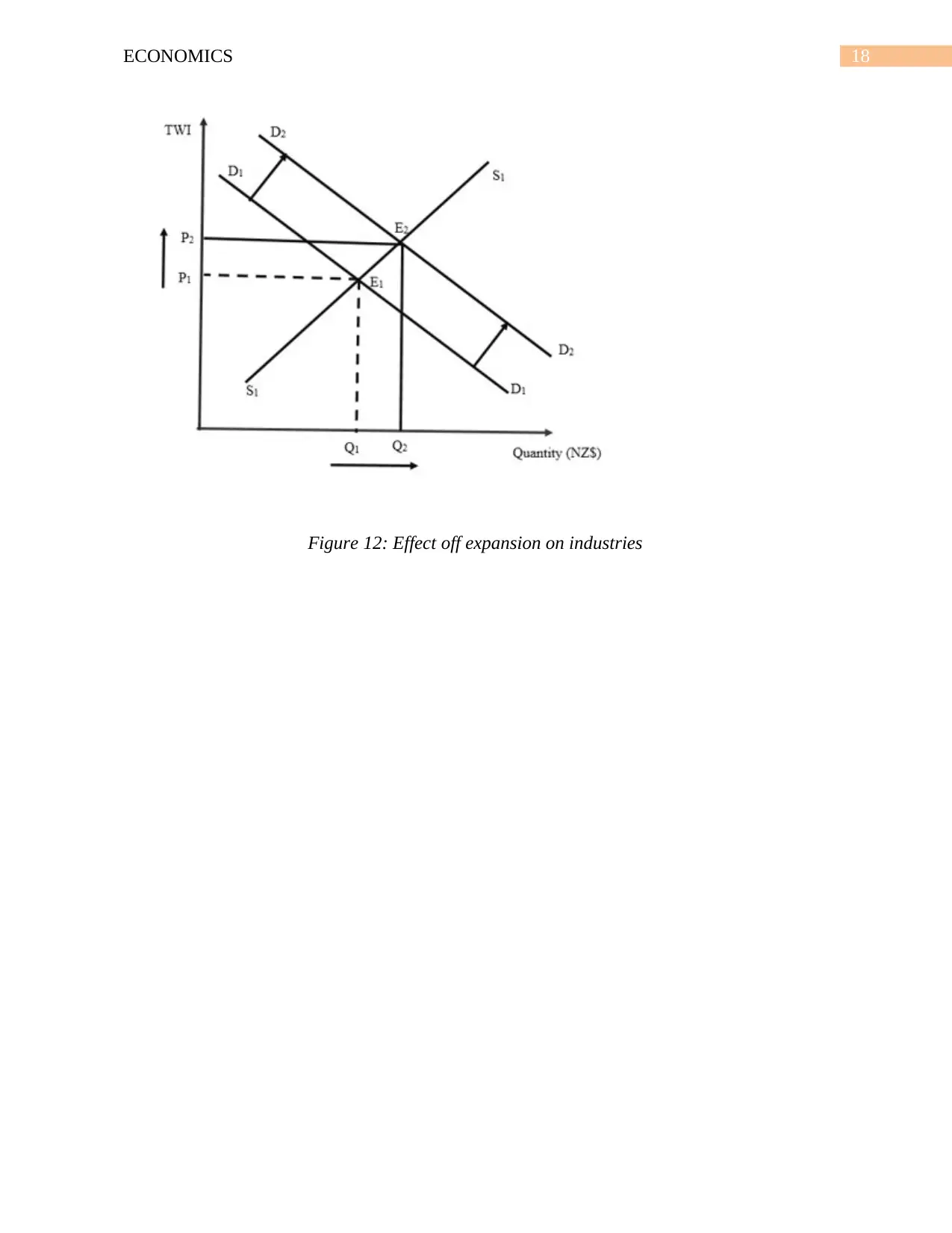
18ECONOMICS
Figure 12: Effect off expansion on industries
Figure 12: Effect off expansion on industries

19ECONOMICS
Reference list
Bandara, Y. M., Sharma, K., & Chakrabarty, D. (2019). Trends, patterns and determinants of
production sharing in Australian manufacturing. Economic Analysis and Policy, 62, 1-11.
Cully, M., Ball, A., Ahmad, S., Bernie, K., McCluskey, C., Pham, P., ... & Feng, A. (2017).
Australian Energy Update: 2015. tech. rep., Department of Industry and Science,
Commonwealth of Australia, Canberra, August 2015. http://www. industry. gov.
au/Office-of-the-Chief-Economist/Publicat ions/Documents/aes/2015-australian-energy-
statistics. pdf, Accessed: 10th January.
Jayaraman, T. K., & Ward, B. D. (2019). Is the money multiplier relevant in a small, open
economy? Empirical evidence from Fiji.
Lowe, P. (2012). The changing structure of the Australian economy and monetary policy. The
Recent Economic Performance of the States 1 Trends in National Saving and Investment
9 The Distribution of Household Wealth in Australia: Evidence from the 2010 HILDA
Survey 19 India’s Steel Industry 29, 79.
Sacilotto, J., & Loosemore, M. (2018). Chinese investment in the Australian construction
industry: the social amplification of risk. Construction Management and Economics,
36(9), 507-520.
Sippel, S. R. (2015). Food security or commercial business? Gulf State investments in Australian
agriculture. The Journal of Peasant Studies, 42(5), 981-1001.
Reference list
Bandara, Y. M., Sharma, K., & Chakrabarty, D. (2019). Trends, patterns and determinants of
production sharing in Australian manufacturing. Economic Analysis and Policy, 62, 1-11.
Cully, M., Ball, A., Ahmad, S., Bernie, K., McCluskey, C., Pham, P., ... & Feng, A. (2017).
Australian Energy Update: 2015. tech. rep., Department of Industry and Science,
Commonwealth of Australia, Canberra, August 2015. http://www. industry. gov.
au/Office-of-the-Chief-Economist/Publicat ions/Documents/aes/2015-australian-energy-
statistics. pdf, Accessed: 10th January.
Jayaraman, T. K., & Ward, B. D. (2019). Is the money multiplier relevant in a small, open
economy? Empirical evidence from Fiji.
Lowe, P. (2012). The changing structure of the Australian economy and monetary policy. The
Recent Economic Performance of the States 1 Trends in National Saving and Investment
9 The Distribution of Household Wealth in Australia: Evidence from the 2010 HILDA
Survey 19 India’s Steel Industry 29, 79.
Sacilotto, J., & Loosemore, M. (2018). Chinese investment in the Australian construction
industry: the social amplification of risk. Construction Management and Economics,
36(9), 507-520.
Sippel, S. R. (2015). Food security or commercial business? Gulf State investments in Australian
agriculture. The Journal of Peasant Studies, 42(5), 981-1001.
Secure Best Marks with AI Grader
Need help grading? Try our AI Grader for instant feedback on your assignments.

20ECONOMICS
Smith, J., & Murphy, C. (1994). Macroeconomic fluctuations in the Australian economy.
Economic Record, 70(209), 133-148.
Stilwell, F. (2017). Erik Paul: Australian Political Economy of Violence and Non-Violence.
Journal of Australian Political Economy, (79), 151-152.
Wang, J., Koblyakova, A., Tiwari, P., & Croucher, J. S. (2018). Is the Australian housing market
in a bubble?. International Journal of Housing Markets and Analysis.
Smith, J., & Murphy, C. (1994). Macroeconomic fluctuations in the Australian economy.
Economic Record, 70(209), 133-148.
Stilwell, F. (2017). Erik Paul: Australian Political Economy of Violence and Non-Violence.
Journal of Australian Political Economy, (79), 151-152.
Wang, J., Koblyakova, A., Tiwari, P., & Croucher, J. S. (2018). Is the Australian housing market
in a bubble?. International Journal of Housing Markets and Analysis.
1 out of 20
![[object Object]](/_next/static/media/star-bottom.7253800d.svg)



